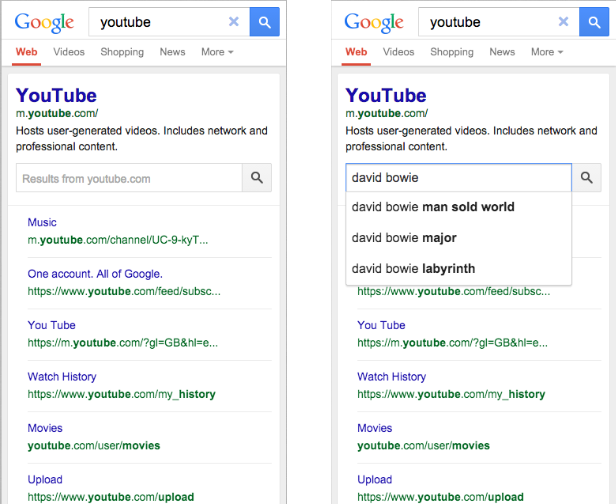Google Search Inception: Why Google Never Wants You To Leave


This month, Search Engine Land spotted Google testing a search feature within search results
Here is a look at Google’s search within search SERP test:

Last week, Google formally announced its improved search box within search. The improved sitelinks search box works within search for company, and product queries, and features autocomplete.
Here’s what Google’s official search within a search looks like:

The new search box in Google search appears above sitelinks, and allows searchers to search within a site on Google searches, performing a site: search on Google rather than navigating to an individual site.
Google search within search features:
Advertisers who want to send searchers directly to their sites search (search on your website vs. Google results) need a site-specific search engine. If you already have one, you can tell Google using schema.org.

Google’s site search box seems to be designed to keep users on Google longer, a change which reflects previous search changes such as the knowledge graph and carousel which follow a similar route- keeping searchers on Google longer.
Google’s search box update on search pages creates a more fluid search experience, but also garners additional ad impressions which would be otherwise lost after the initial search. For Google this means more ad impressions, more clicks, and ultimately more revenue.
Google can also use this move to continue to collect more user information, which helps Google understand how people search:
“The longer searchers stay on Google, the more information about the nature of search behavior is at their fingertips. Rather than sending someone to zappos.com where a user might perform a search to find what they’re actually looking for, the user can do that on Google and they’ll collect the data.
I see this going a long way for understanding branded/trademarked searches better. Rather than just clicking through on a Zappos.com trademark ad, I do additional searches and those searches tell Google a lot more about WHY users are coming back to that site. This can have implications on how Google truly understands your site, and how they index you organically as well as with paid ads.
If Google wants to understand INTENT of users beyond what’s represented in the original query then this can go a long way.”
Google wants to keep people on their site longer. Although Google is widely used, Google’s main challenge for monetization has been keeping people on their site longer for more impressions and ad spend. Their site has worked as a pass through for so long that they are trying to change user behavior, hence all of the minor tweaks that have been made that negatively impact organic search.
Google’s loyalty lies to their advertisers and most, if not all of their decisions to their SERPs, have been to get people to click more on higher targeted advertising. If anything, this will make it even more important that from a text ad perspective we’re closely building out ad groups and keyword targeting for specific search intent within a client’s website.
For Google PPC, the search box might affect larger sites with a drop in pages per visit and time on site . Ideally, bounce rate will decrease because the search results that will display will be much more granular. Lower bounce rates should have a positive impact on ad performance (assuming you are building out highly targeted ad groups) because it helps negate bad site navigation structure and other website structure variables.
Google’s site search box puts more emphasis on the structure of AdWords accounts, because you can mitigate a poor site categorization structure with tightly-themed, well structured AdWords accounts.
For example, if you are Williams-Sonoma, and you have just one ad group for Utensils, with keyword targets for all your utensil products, and a catch-all ad, then you can survive a “first-round” search like “williams sonoma kitchen knives”.
Your ad would appear and look like:

But if the user then searches within that search for “Chopping Knives”
Then you better have an ad group for Knives, and better yet, Chopping Knives, with a specific ad, otherwise your ad would just be repeated, presumably, and that’s not an optimal UX
At the end of the day (for the time being), Google will still be responsible for dropping people on to another website. Whether or not this helps increase click rates for our ads remains to be seen.
